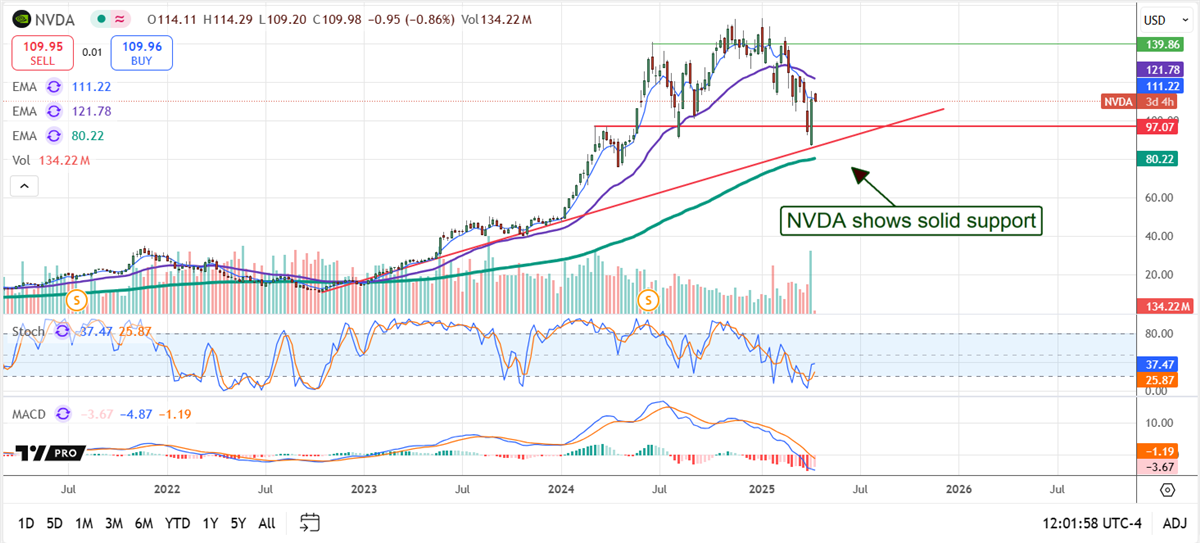 NVIDIA analysts trimmed targets and reduced ratings in early April, setting the market up to rebound strongly in late Q2 with the next... ͏ ͏ ͏ ͏ ͏ ͏ ͏ ͏ ͏ ͏ ͏ ͏ ͏ ͏ ͏ ͏ ͏ ͏ ͏ ͏ ͏ ͏ ͏ ͏ ͏ ͏ ͏ ͏ ͏ ͏ ͏ ͏ ͏ ͏ ͏ ͏ ͏ ͏ ͏ ͏ ͏ ͏ ͏ ͏ ͏ ͏ ͏ ͏ ͏ ͏ ͏ ͏ ͏ ͏ ͏ ͏ ͏ ͏ ͏ ͏ ͏ ͏ ͏ ͏ ͏ ͏ ͏ ͏ ͏ ͏ ͏ ͏ ͏ ͏ ͏ ͏ ͏ ͏ ͏ ͏ ͏ ͏ ͏ ͏ ͏ ͏ ͏ ͏ ͏ ͏ ͏ ͏ ͏ ͏ ͏ ͏ ͏ ͏ ͏ ͏ |
| | Written by Thomas Hughes  NVIDIA (NASDAQ: NVDA) analysts started reducing their ratings and price targets in late March, which presents a headwind for the stock price action. NVIDIA (NASDAQ: NVDA) analysts started reducing their ratings and price targets in late March, which presents a headwind for the stock price action.
MarketBeat tracks five consecutive negative revisions beginning March 20, including three price target reductions and two downgrades. The downgrades are from Buy or Strong Buy to Hold, and the net result could be a cap on the market. Regardless of where the consensus target forecasts the stock price, a trend in negative revisions saps investor appetite. This could lead to an even deeper market correction than NVIDIA has already seen. The risk now is that negative revisions will become the trend. However, not all analysts are cutting their targets. The five-revision trend that began in late March ended in mid-April when Bank of America reiterated its rating and target. Analysts at Bank of America peg this stock at Moderate Buy, aligning with the broad consensus, and see it advancing to $200 or nearly 80% upside relative to the April 14th price action. They cite the tariff pause as a catalyst for the business. While the pause does not end the risk of tariffs, it is seen as a catalyst for policy action on Capitol Hill to support and accelerate the onshoring of U.S. semiconductor manufacturing. NVIDIA Announces $500B U.S. AI Infrastructure Build-Out NVIDIA plans to manufacture half a trillion dollars in AI infrastructure domestically within four years. The bold claim is supported by ongoing investment in Arizona and Texas facilities, including Taiwan Semiconductor (NYSE: TSM) and Foxconn, which are intended to ramp up production for NVIDIA and other prominent semiconductor firms. The goal for NVIDIA is for 100% domestic production of its most advanced chips, including Blackwell and Rubin line-ups, front and back end, packaging, and testing. As it is, the company expects to begin ramping up domestic production at two Texas facilities within the next 12 to 15 months. It has already commissioned more than 1 million square feet of manufacturing space. 
NVIDIA Downgrades Set Stock Up to Surge in Q2 As much risk as there is for NVIDIA analysts to cap gains in 2025, the downside is limited because of the stock’s low valuation and outlook for business growth. NVIDIA revenue growth is expected to continue slowing due to the law of large numbers and maturing AI markets, but it will sustain a moderate to low double-digit pace through the end of the next decade. This forecast puts the stock under 10x its earnings by the middle of the next decade, presenting a generational buying opportunity. The stock price could easily double in this scenario, and the odds are high that it will rise significantly more because the forecasts are likely too low. Clouds and economic headwinds in early 2025 impacted the outlook, but when they ease, global business, including AI infrastructure build, can regain momentum. The catalyst could come with the Q2 earnings report due at the end of May, when the company issues another solid report and provides positive guidance. NVIDIA Could Set New Highs Before Its Q2 Earnings Report Because of the technical setup and analyst forecasts, NVIDIA could set new highs before its Q2 earnings report is released. Although some analysts have trimmed targets and the consensus has fallen from a peak, it forecasts a 50% upside for this stock, sufficient to exceed the current all-time high by 1500 basis points and could be reached quickly. Once this market clearly indicates it is moving higher, investor capital will start to flood into it and drive the stock price to the $190 range or higher.  Read This Story Online Read This Story Online | Elon Strikes Back
You may already sense that the tide is turning against Elon Musk and DOGE. Just this week, President Trump promised to buy a Tesla to help support Musk in the face of a boycott against his company. But according to one research group, with connections to the Pentagon and the U.S. government, Elon's preparing to strike back in a much bigger way in the days ahead. Click here to see what they're predicting now. |
| Written by Leo Miller 
Amid the precipitous decline in the general market in 2025, several new stocks on the block have managed to outperform. As of the April 11 close, the S&P 500 Index has provided a total return of nearly down 9%. Three stocks that had their initial public offerings (IPOs) in 2024 or 2025 have achieved returns between down 2% and up 25% this year, beating the S&P: Tempus AI (NASDAQ: TEM), ServiceTitan (NASDAQ: TTAN), and CoreWeave, Inc. Class A Common Stock (NASDAQ: CRWV). Here's why. Tempus AI: Shares Up Solidly in 2025 Despite Big Slide AI-centric healthcare stock Tempus AI has provided a very strong return on the year of just under 25%. In January, the firm launched its AI-enabled health concierge app, Olivia, which could significantly enhance its overall business. App usage could lead to significantly more people purchasing the company's genomic sequencing service. Tempus AI sells this genomic data to drug development companies, multiplying the initial sequencing revenue several times over in subsequent years. Tempus AI also made multiple acquisitions in 2025 that can help increase its access to data and provide other complementary capabilities. That said, the stock hasn’t had a smooth ride. While Tempus AI was up as much as 164% by mid-February, shares have pulled back significantly. A sharp 15% drop followed the company’s most recent earnings report, in which it missed estimates on both sales and adjusted earnings per share (EPS). However, the company is still growing at a brisk pace, seeing sales rise by nearly 36% in Q4 2024. Tempus AI believes it will achieve positive full-year adjusted earnings before interest, taxes, depreciation, and amortization (EBITDA) for the first time in 2025. Analysts have given TEM stock a Moderate Buy rating, with a consensus price target of $61.18—representing nearly 43% upside form where its currently trading. ServiceTitan: Bringing Tech to the Trades and Outperformance in 2025 ServiceTitan had a much-talked-about IPO in mid-December 2024. The company is working to modernize “the trades," bringing management software and technology to industries that traditionally have been slow to digitize. Overall, the stock is down just 2% in 2025 so far, still beating the S&P. The firm’s financial performance in Q4 2024 was impressive, beating revenue estimates by over $9 million and adjusted net income estimates by nearly $7 million. The company’s 2025 sales guidance came in solidly higher than expected. While growing its revenues by north of 25% for multiple years, the company has also made impressive progress in improving its profitability. Its adjusted operating margin has increased from dwon 32% to up 3% in just under three years. ServiceTitan believes it has a significant runway to continue growing its business. Based on the markets it currently serves, it sees a serviceable addressable market of $13 billion. This is around 17x higher than the revenue it generated over the last 12 months. As the firm grows its product features and works into new markets, it believes it has a total addressable market of over $30 billion. TTAN stock has received a Moderate Buy rating from analysts with a nearly is projected upside 12%. CoreWeave: Stock with NVIDIA and OpenAI Ties Doing Well Since IPO When CoreWeave went public on March 28, 2025, it gained a large amount of attention. This was primarily due to the fact that chip giant NVIDIA (NASDAQ: NVDA) owns approximately 5% of CoreWeave's shares. Companies with investments from NVIDIA have seen their share prices soar since they disclosed this information. Investors want to place their bets where NVIDIA, arguably the world’s most important tech company right now, places theirs. OpenAI also has a $350 million investment in the firm and inked a nearly $12 billion deal. CoreWeave rents out access to NVIDIA’s graphics processing units (GPUs), which it has amassed over 250,000 of, through the cloud. Customers access this hardware to run or train their AI models. CoreWeave shares are up over 9% in 2025 so far. Given CoreWeave's recent IPO, analyst coverage is low. However, it is worth nothing that D.A. Davidson currently rates the stock as a Hold, but has issued a price target of $47.00, a 4.37% upside from where it trades today. All performance data is as of the April 11 close unless otherwise noted.  Read This Story Online Read This Story Online | |
| Written by Nathan Reiff 
Investors commonly see dividend-paying stocks as a stable, defensive part of a portfolio. These firms should, in theory, pay out a steady stream of passive income in the form of regular dividend payments made possible by the company's continued operational success. Thus, some of the most popular dividend names are blue-chip names like Coca-Cola Co. (NYSE: KO) and Procter & Gamble Co. (NYSE: PG). There is another way for investors with a greater risk tolerance to approach dividend names as well. Particularly given the recent turbulence in the market, several dividend-paying names have experienced significant price drops that have brought them into penny stock territory. To be sure, companies like Global Self Storage (NASDAQ: SELF), ACCO Brands Corp. (NYSE: ACCO), and Mativ Holdings Inc. (NYSE: MATIV) do not have the stability of a Coca-Cola or P&G, and their ability to continue to pay dividends—or to continue to pay them at the same sustained level—is not nearly as secure as those larger firms. However, each of these companies is trading at a relative discount, and each has the support of at least one optimistic Wall Street analyst. 5.88% Yield and Market Outperformance — Is This REIT the Ultimate Defensive Play? As a real estate investment trust (REIT), Global Self Storage must pay investors 90% or more of its taxable income in disbursements. Unlike some REITs, which focus on office or data center properties and are heavily tied to the economy's overall strength, Global's purview is self-storage properties. Given low operating costs and relatively stable demand, the self-storage business could constitute a reasonable defensive play in markets that are not oversaturated with options. Although it has declined by nearly 7% year-to-date (YTD), Global has outperformed the S&P 500 over April 11, 2025. The company has a dividend yield of 5.88% and marginal annualized 3-year dividend growth. With a dividend payout ratio of more than 161%, Global may be at risk of overpaying dividends. This may be one reason why the company recently agreed to an at-market offering of up to $15 million of common stock in partnership with Alliance Global Partners. The firm also beat analyst predictions for EPS in the most recent quarter by a healthy margin of 11 cents per share. This 8.2% Dividend Stock Is Down 30% — Bargain or Value Trap? With a whopping 8.21% dividend yield, dividend investors are likely to consider office and school supply manufacturer ACCO Brands. But the huge yield comes with a few important caveats. First, ACCO has experienced a declining top line for the last several years, and uncertainties around the potential impact of tariffs further threaten the company's sales. Due to impairment charges, net income has also been negative in multiple recent periods. However, the company has been able to generate substantial free cash flows of at least $100 million per year. ACCO's efforts to cut costs have improved margins and reduced debt load in recent months, further making the stock more attractive to investors. Still, shares are down about 30% YTD as of April 11, although that has given the company a price-to-sales ratio of just 0.2. For investors optimistic that the company will navigate the tariff environment smoothly and turn around sales trends, Barrington Research shares in this optimism and has assigned ACCO a Buy rating and a price target of $7.00 per share, just about double the current price point. High-Risk, High-Reward Manufacturing Dividend Play Specialty materials manufacturer Mativ Holdings may be our list's highest-risk, highest-reward play. The company's operations leave it potentially exposed to significant tariff risk, and as of April 11, it had experienced a 55% share price decline YTD, compounded by an earnings miss in February. On the other hand, though, Mativ offers the highest dividend yield of these three firms at 8.27%, and analysts at Stifel Nicolaus upgraded the firm from Hold to Buy in March, setting a price target of $10. This is more than double the current price of MATV shares. Investors seeking dividends and willing to take a risk could see big rewards for an investment in Mativ, if that prediction comes to pass.  Read This Story Online Read This Story Online | |
| More Stories |
| |
|
|
No comments:
Post a Comment